Area: 217 sq.km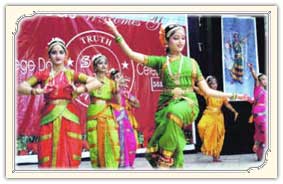
Altitude: 536 Mts
Summer: Max 40 C and Min 22 C
Winter:Max 22C and Min 13.8C
Rainfall:89cm ( June to Sept )
Best Time to visit:June to February
STD Code:040
State:Andhra Pradesh
History Of Hyderabad
Hyderabad, the capital of Andhra Pradesh is a bustling 400 year old metropolis with an urban population of 4.2 million people approximately. The city is cosmopolitan, and is richly endowed with a variety of cultures. The city presents an attractive amalgam of old world charm together with ebullience of growth and enterprise. Beautiful old edifices built in the medieval, large glass and chrome temples of commerce. The history of Hyderabad begins with the establishment of the Qutub Shahi dynasty. Quli Qutub Shah seized the reins of power from the Bahamani Kingdom in 1512 and established the fortress city of Golconda. Inadequacy of water, and frequent epidemics of plague and cholera persuaded Mohammed, the fifth Quli Qutub Shahi ruler to venture outward to establish the new city with the Charminar at its center and with four great roads fanning out in the four cardinal directions. Hyderabad's fame, strategic location and Golconda's legendary wealth attracted Aurangazeb who captured Golconda after a long siege in 1687. After this defeat the importance of Hyderabad declined and the city fell into partial ruin.
As the Mughal Empire decayed and began to disintegrate, the victory, Asaf Jah-I proclaimed himself the Nizam and established independent rule of the Deccan. Hyderabad once again became a major capital city, ruled by successive Nizams of the Asaf Jah dynasty until the state was merged into the Indian Union in 1948.
In 1798, a subsidiary alliance for military and political cooperation was signed between the Nizam and the British East India company. Thereafter, an area north of what is now the Hussain Sagar lake was established as a cantonment. The area was named Secunderabad after the then Nizam, Sikander Jah. Both Hyderabad and Secunderabad grew together and have now merged. An imaginary line drawn across the Tank Bund is still used to distinguish the two cities..
Culture Of Hyderabad
The infamous Hyderabadi pearl Culture. Who hasn't heard about the soft, rounded, luminescent, tear drop pearl of Hyderabad. People form everywhere flock here to possess a few of these pearls. But why Hyderabad? It neither is on the sea coast nor near to it. Yet it has become almost synonymous with pearls. It is because of the city's grand and very old history. Hyderabad was a princely state and a very rich one too! The royal patronage saw to the burgeoning growth of arts, crafts and cuisine. Their rich life-styles beckoned many a craftsman from distant parts of the world, especially the Arabian Gulf where the rare original pearls are found in abundance. Hence, Hyderabad became the one-stop-destination for pearls. There is an entire street which only comprises of pearl shops - Patther Gatti.
Tourist Destinations in Hyderbad
Hyderabad is important tourist destinatons of South India.Sightseeing At Hyderabad
Golconda fort
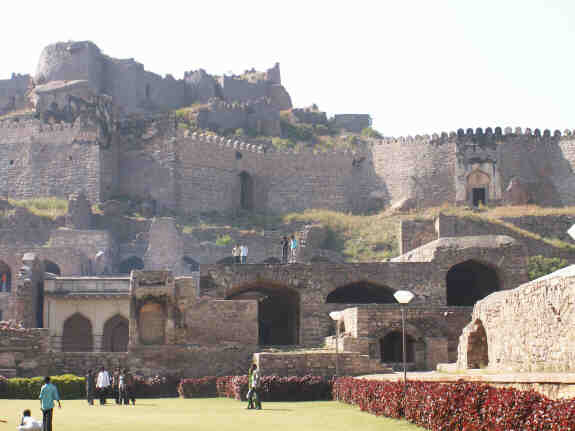
The documented history of Golconda goes back to the Kakatiya Dynasty in 11th century when they built a mud fortress on a hill called Golconda. During the span of 800 years from Kakatiya to Qutub Shahi rulers, the fort-city grew and prospered. During the reign of Qutub Shahi rulers, espically at time of Mohammed Qutub Shahi the culture reaches its zenith. Most of the places of interest in the area pertain to Qutub Shahi Era. The majestic ruins of Golconda stands as a backdrop to the city of Hyderabad. The orginal fort was built by Kakatiyas in 1143. It went to the hands of Bahmani Kings in (1364-1507). Quli Qutub-ul- Mulk declared Golconda as an independent Kingdom and assumed the title of Sultan Quli Qutub Shahi I. The original mud fortress was strengthened during the next 62 years. The walls and bastions were built of large blocks of masonry, some weighing 7 tons. The fort's outmost walls traverse a circumference of approximately 7km with 87 semicircula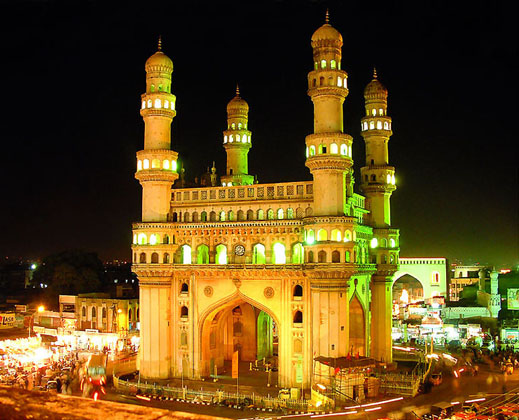 r bastions and 8 huge gates. The majority of people lived with in the fort walls. Golcanda was a flourishing market of priceless gems. The famous Kohinoor diamond which now adorns the British Crown went to the hands of Aurangazeb from here.
r bastions and 8 huge gates. The majority of people lived with in the fort walls. Golcanda was a flourishing market of priceless gems. The famous Kohinoor diamond which now adorns the British Crown went to the hands of Aurangazeb from here.
: It is the principal landmark of Hyderabad. In 1591, Mohamed Quli Qutub Shah built Charminar to commemorate the end of a devastating epidemic. Charminar, which means four towers, stands 56m high and 30m wide creating four arc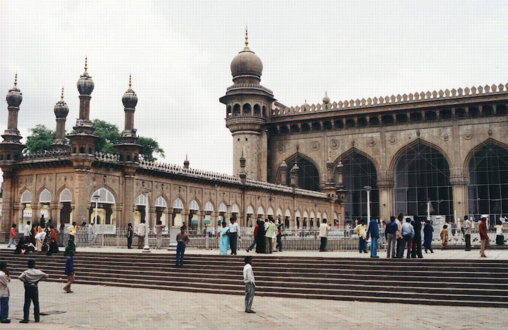 hes facing each of cardinal points. The lower area of the Charminar is open daily 9am to 4.30pm. The structure is illuminated during the night from 7pm to 9pm.
hes facing each of cardinal points. The lower area of the Charminar is open daily 9am to 4.30pm. The structure is illuminated during the night from 7pm to 9pm.
One of the largest mosques in the world, it can accommodate up to 10,000 worshipers. Mecca Masjid is situated adjacent to the Charminar. Mohamed Quli Qutub Shah built the mosque. Construction began in 1614 and Aurangazeb completed it in 1687. The name of Mecca Masjid was given to the mosque since many bricks embedded above the gate are made from the soil brought from Mecca. Non-Muslims are not allowed to enter the Masjid. But one can definitely appreciate the architectural features of the mosque from outside.
Laad BazarSituated on the right side of Charminar, Laad Bazar is one of the oldest shopping centers of the city. The Bazar is famous for bridal ware, henna, cosmetics, bangles etc. You will find almost everything in the Bazar.
Salar Jung Museum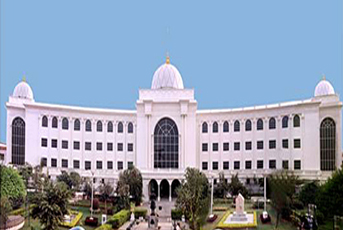
A major attraction for art lovers, Salar Jung Museum was put together by Mir Yousuf Ali Khan (Salar Jung III), the Prime Minister of Nizam Osman Ali Khan. One of the largest private collections in the world that covers exhibits from every part of the world, the museum has over 35,000 items comprising of wood carvings, sculptures, Persian miniature paintings, weaponry and a library of 50000 books. The museum is located near the Musi River Bridge. The museum is open every day from 10 AM to 5 PM except Fridays.
Birla PlanetariumOn the hill adjacent to the Birla Mandir is the Birla Planetarium and the Science Museum. The planetarium has daily session in Telugu, English and Hindi. The science museum is open from 1030hrs to 2015hrs daily except last Tuesday of every month.
Hussain Sagar Lake(TANK BUND)Hazrat Hussain Shah Wali built The Bund in 1562 during the reign of Ibrahim Qutub Shah. Tank Bund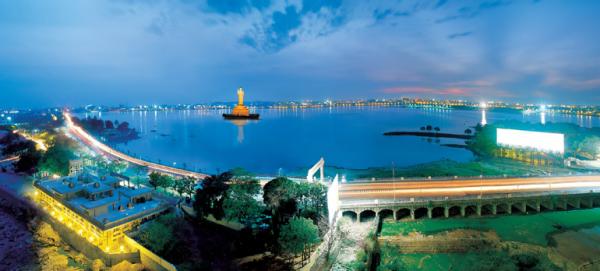 once a water source for the Secunderabad Contonment is now a recreational facility and a picnic spot with facilities for water sports. The largest stone statue of Buddha in the world, weighing 350 tons and 17.5 meter tall, is located on a plinth in the middle of the lake.
once a water source for the Secunderabad Contonment is now a recreational facility and a picnic spot with facilities for water sports. The largest stone statue of Buddha in the world, weighing 350 tons and 17.5 meter tall, is located on a plinth in the middle of the lake.
The royal cemetery of the Qutub Shahi kings lies about 2km from the Golconda Fort. The tombs are a scattered group of large domes and terraces. Perhaps this is the only place in the world where one can see so many tombs in one place. All the Qutub Shahi kings except Abdul Hassan Tana Shah who died in captivity in Daulatabad are buried here. These graceful domed tombs are surrounded by landscaped gardens. They are open daily from 0930hrs to 1630hrs except on Fridays.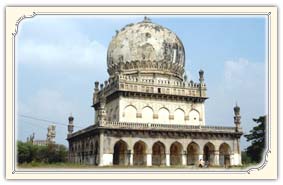
The Paigah nobles ranked next in hierarchy to the ruling family of the Nizams. They have constructed many palaces including Falaknuma Palace. Several generations of Paigah nobles are buried in one place and the tombs are built along Persian style with stucco and inlay works of Rajasthani style.
Lumbini ParlThis is a new amusement park at Tank Bund and has a musical fountain show at 630PM and 8.00PM every day except Mondays.
Osmaniya UniversityWith Urdu as the medium as the medium of instruction, Osmaniya University has one of the largest campuses in India. It was founded in 1919. The building for Arts College was designed by Nawab Zai Yar Jung, Nizam's architect, after studying several European Universities. Most of other Faculty buildings in the Campus all have the same line as the Arts College that blends European and Indian styles. The buildings, the botanical gardens and the landscaped gardens - all are worth and rewarding to visit.
Sadani Ma Ki DargaThe stunning mausoleum built in 1883 is situated on the main road near Secunderabad end of Tank Bund.
Holy Trinity Church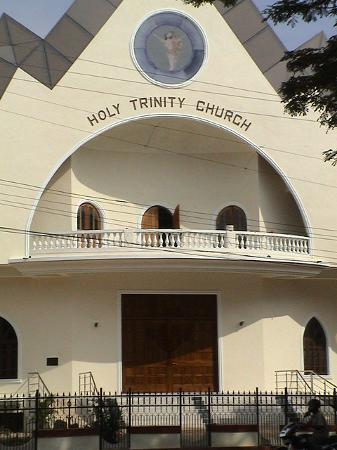
Built in 1846 with a donation from Queen Victoria on the land gifted by the Nizam. This protestant church has frosty white spires and stained glass windows.
Afazalganj MsjidSituated very close to the Naya Pul (New Bridge), this Qutub Shahi mosque was built by Abdulla Qutub Shah. It is a fairly large mosque with beautiful latticework characteristic of Qutub Shahi mosques.
How To Reach HyderabadBy Air: Hyderabad's Begumpet Airport has a number of daily flights to the major cities of the country.
By Rail: Hyderabad railway station is well connected to all the major Indian cities. There are a number of daily express trains from Hyderabad to the other cities of India.
By Road: Hyderabad has a large bus terminus and is well connected to other cities in the state by a network of highways. The Andhra Pradesh State Road Transport Corporation (APSRTC) buses and buses belonging to other South Indian State Roadways also operate from here. The APSRTC also conducts a number of tours and excursions around the city.

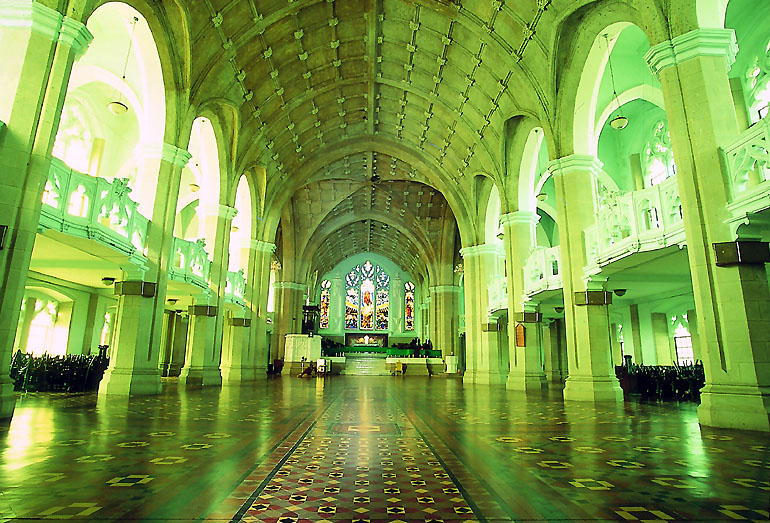
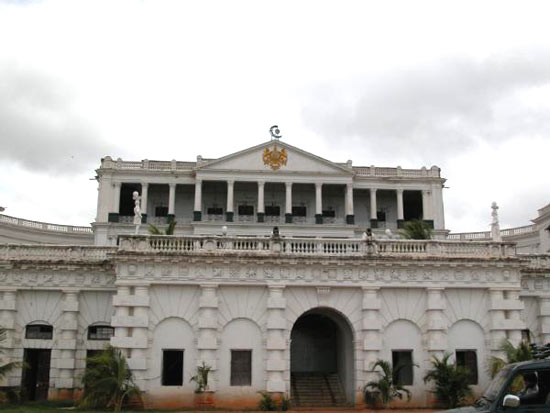
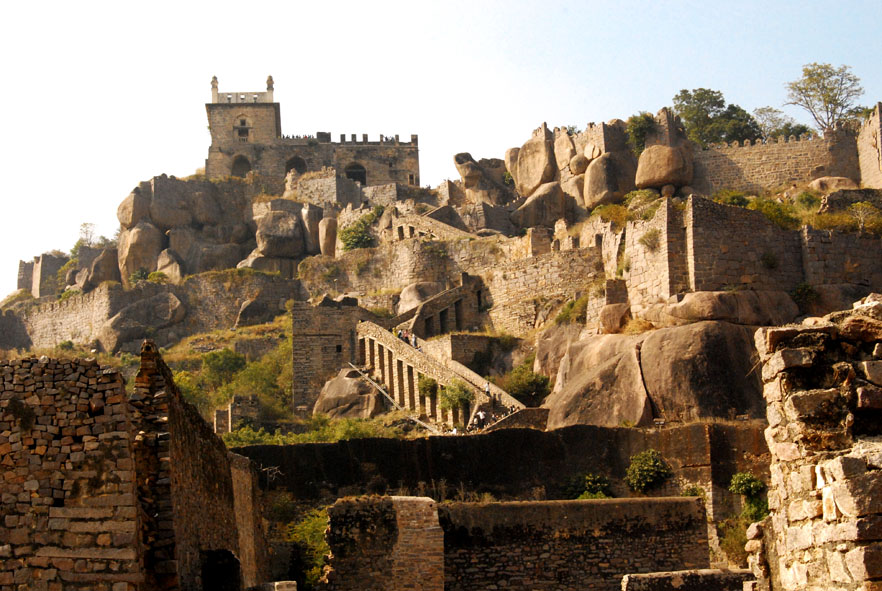
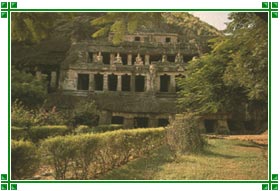
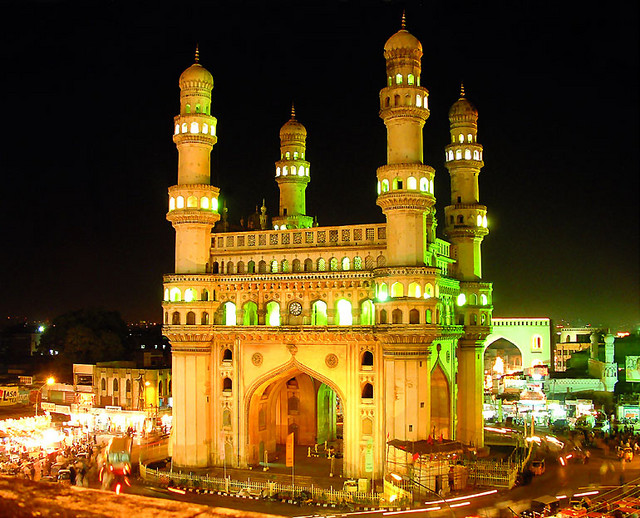
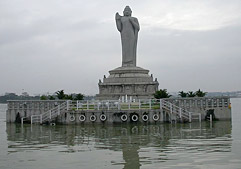
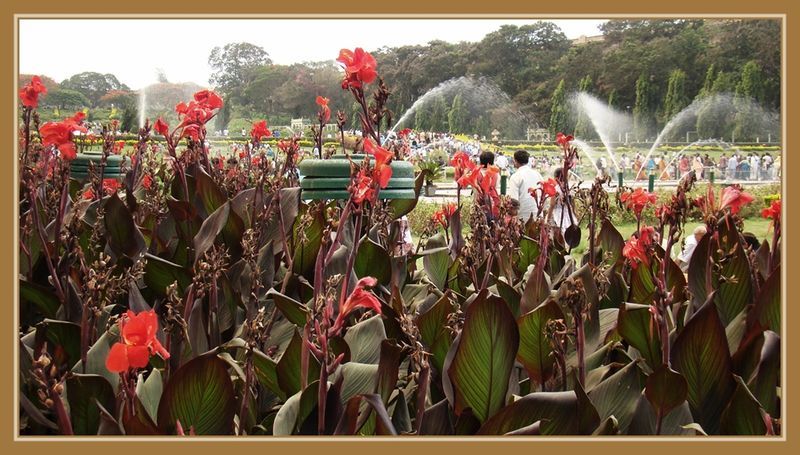
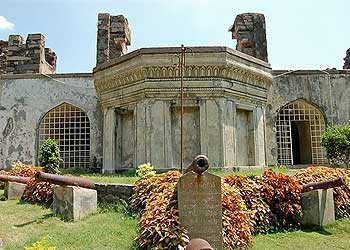


 Goa
Goa  Kerala
Kerala  Agra
Agra 



Wild Life Parks